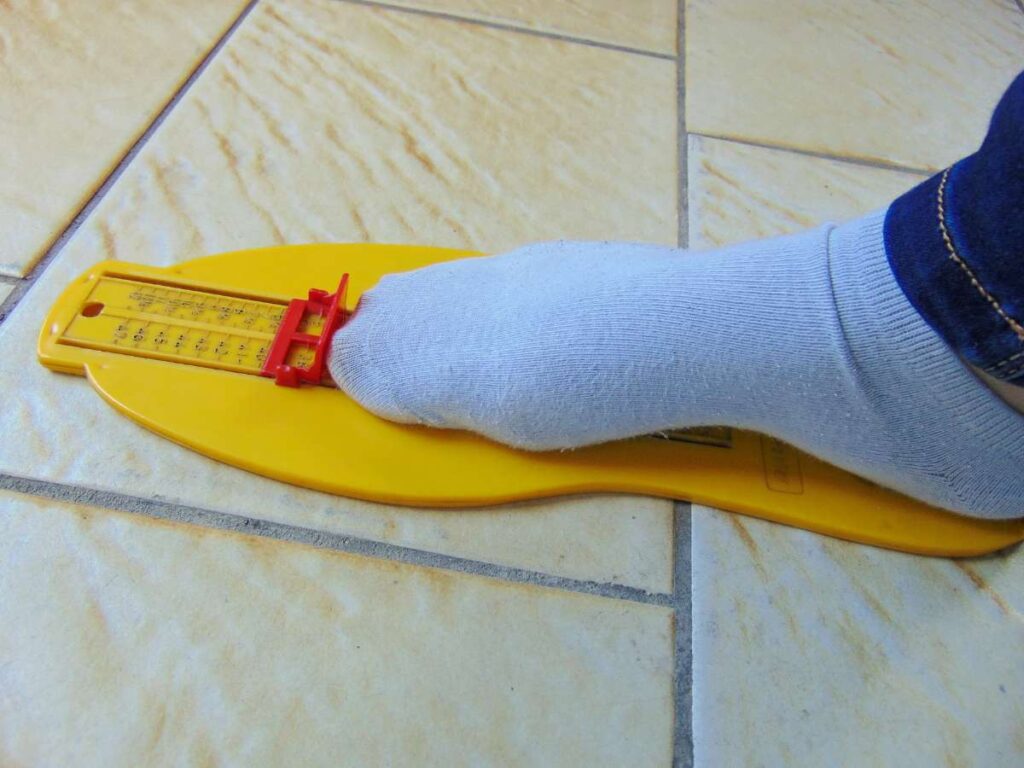Shoe Sizing: A Quick Guide for Perfect Fit

Author: Andy Hong | Founder at XDS
Hi, I'm Andy Hong, here to share my expertise in footwear manufacturing with you.
Shoe Sizing: A Quick Guide for Perfect Fit
Table of Contents
Struggling to decode shoe sizes when sourcing footwear in China? Understanding China’s unique sizing system is key to establishing a perfect fit and avoiding costly mistakes.
As a footwear manufacturing consultant specializing in international size standardization, my years of experience in global footwear sourcing provide accurate and actionable insights for decision-makers.
China’s shoe sizing uses millimeter-based measurements, differing from the inch-based systems commonly used in the U.S. and UK. This precise system requires careful interpretation to meet customer expectations and ensure production consistency.
In this guide, we will explore the fundamentals of China’s sizing system and tips for establishing a flawless fit. These insights will help streamline sourcing and avoid unnecessary errors.
Let’s dive into it!
1. Steps on How to Measure Foot Size Correctly
A proper measuring process captures the foot’s natural shape and weight distribution, providing a reliable guide for selecting the ideal shoe. Here are the essential steps to measure foot size with accuracy and consistency:
- Prepare the Tools and Surface: Gather a clean sheet of paper, a sharp pencil, and a ruler or measuring tape to guarantee accurate results. The surface used should be flat, even, and stable to prevent any distortions in the outline or measurements.
- Position the Foot Correctly: Stand naturally on the paper with weight evenly distributed across both feet. This step is critical as it captures the foot’s full size under normal conditions, avoiding inaccuracies caused by sitting or uneven pressure.
- Trace the Foot Outline: Hold the pencil firmly and keep it perpendicular to the paper while carefully tracing the outline of the foot. Pay close attention to details around the toes, arch, and heel to achieve an accurate representation of the foot’s shape and size.
- Measure the Length and Width: Using a ruler or measuring tape, measure the length of the foot from the farthest point of the heel to the tip of the longest toe. Similarly, measure the width by identifying the broadest area across the ball of the foot for a comprehensive size assessment.
- Account for Both Feet: Repeat the entire process for the other foot, as it is common for one foot to be slightly larger than the other. Use the larger measurement as the reference point when determining the appropriate shoe size for a more comfortable fit.
2. Factors That Influence Shoe Sizing
Shoe sizing is not solely determined by the length and width of the foot. Below are the key factors that influence shoe sizing and comfort:
Material Properties
The type of material used in the shoe greatly affects its fit and feel over time. Natural materials like leather tend to stretch and mold to the shape of the foot, creating a snug fit after a few uses. Synthetic materials, on the other hand, may maintain their original shape and offer less flexibility. These differences mean that shoes made from different materials may require slightly different sizes to achieve optimal comfort.
Shoe Design and Style
The design and style of a shoe also play a crucial role in determining the appropriate size. Pointed-toe shoes, for example, may require a larger size to accommodate the shape of the foot, while wide or round-toe designs offer more room. Similarly, at XDS, our athletic shoes are designed with extra padding or specific contours that can alter the way they fit compared to casual or formal footwear.
Foot Shape and Structure
The unique structure of each individual’s foot, including arch height, toe length, and overall shape, can impact sizing. High arches or flat feet may require additional support or specific design features, which can affect the way shoes fit. Additionally, foot conditions like bunions or hammertoes may necessitate choosing a size or style that provides extra room or flexibility.
Activity Level and Wear Frequency
The level of activity and frequency of shoe wear can also affect sizing needs. At XDS, shoes that are intended for rigorous activities, such as running or hiking, often require a slightly larger size to accommodate thicker socks or swelling from prolonged use. Similarly, shoes worn daily may benefit from additional space to provide long-term comfort and prevent wear-related discomfort.

3. Global Shoe Sizing Chart
Men’s Shoe Sizing Chart
| Length of Foot (cm) | Length of Foot (inches) | US Size | UK Size | China Size |
| 23.7 | 9 5/16 | 6 | 5.5 | 39 |
| 24.1 | 9 1/2 | 6.5 | 6 | 39.5 |
| 24.6 | 9 11/16 | 7 | 6.5 | 40 |
| 25 | 9 13/16 | 7.5 | 7 | 41 |
| 25.4 | 10 | 8 | 7.5 | 41.5 |
| 25.8 | 10 1/8 | 8.5 | 8 | 42 |
| 26.2 | 10 5/16 | 9 | 8.5 | 43 |
| 26.7 | 10 1/2 | 9.5 | 9 | 43.5 |
| 27 | 10 11/16 | 10 | 9.5 | 44 |
| 27.5 | 10 13/16 | 10.5 | 10 | 44.5 |
| 27.9 | 11 | 11 | 10.5 | 45 |
Women’s Shoe Sizing Chart
| Length of Foot (cm) | Length of Foot (inches) | US Size | UK Size | China Size |
| 21 | 8 1/4 | 4 | 2 | 34 |
| 21.5 | 8 7/16 | 4.5 | 2.5 | 34.5 |
| 22 | 8 11/16 | 5 | 3 | 35 |
| 22.4 | 8 13/16 | 5.5 | 3.5 | 35.5 |
| 23 | 9 1/16 | 6 | 4 | 36 |
| 23.4 | 9 3/16 | 6.5 | 4.5 | 36.5 |
| 24 | 9 7/16 | 7 | 5 | 37 |
| 24.5 | 9 5/8 | 7.5 | 5.5 | 37.5 |
| 25 | 9 13/16 | 8 | 6 | 38 |
| 25.5 | 10 | 8.5 | 6.5 | 38.5 |
| 26 | 10 3/16 | 9 | 7 | 39 |
4. Common Mistakes in Foot Measurement
Accurate foot measurement is critical for selecting the right shoe size, yet small errors can lead to discomfort and ill-fitting footwear. Understanding the common pitfalls ensures measurements are precise and reliable. Here are the most frequent mistakes made during foot measurement and how to avoid them:
Measuring Feet at the Wrong Time of Day
The time of day can impact foot size due to natural swelling that occurs from daily activity. Measuring feet early in the morning may not reflect their full size, leading to shoes that feel tight by the end of the day. Foot measurements are most accurate when taken in the late afternoon or evening when swelling has peaked, providing a better basis for selecting a comfortable size.
Using Improper Tools or Techniques
Using makeshift tools, such as estimating measurements with a string or an unreliable ruler, can lead to inaccuracies. For instance, holding the pencil at an angle while tracing the foot outline may distort the shape and result in incorrect measurements. For consistent results, tools such as a flat ruler, measuring tape, and properly positioned pencil are recommended.
Relying on One Measurement for Both Feet
Feet are often slightly different in size, which makes measuring only one foot a significant mistake. Relying on the smaller foot’s measurement can result in discomfort for the larger foot, especially during extended wear. Both feet should be measured individually, with the larger measurement used as the reference point when selecting shoes to ensure a proper fit.

5. 4 Tips on How to Choose the Right Shoe Size
Selecting the right shoe size requires more than just matching foot measurements to a chart. Here are 4 specific and technical tips to guide the selection of the correct shoe size:
#1 Account for a Fit Tolerance of 0.5–1 cm
Shoes should allow for a fit tolerance of 0.5–1 cm between the tip of the longest toe and the front of the shoe. This additional space accommodates natural movement during walking or running, reducing the risk of toe compression and injuries like blisters or calluses. For high-impact activities, such as running or hiking, prioritizing the upper end of this tolerance range enhances comfort and mobility.
#2 Evaluate Width Specifications in Millimeters
Width measurements, such as 2A (narrow) or E (wide), are just as important as length when selecting shoes. A mismatch in width can lead to excessive pressure on the sides of the foot or an unstable fit. For example, a standard D width for men’s shoes suits most average foot shapes, but wider feet may require 2E or higher.
#3 Consider Material Stretch Ratios
Materials like leather and knit fabrics can stretch over time, altering the shoe’s fit. Leather typically stretches up to 10% of its initial size, while synthetic materials may stretch less or maintain their original dimensions. When buying leather shoes, choosing a slightly snug fit is advisable to allow for this natural expansion. Conversely, synthetic materials require precise sizing as they provide minimal adjustments after wear.
#4 Adjust for Activity-Specific Fit Requirements
Different activities demand variations in fit to enhance performance and prevent discomfort. For running shoes, an allowance of 1–1.5 cm in the toe box helps reduce impact on the toes during forward motion. For weightlifting shoes, a snug fit with minimal extra space enhances stability and balance during lifts. Always align fit requirements with the intended purpose of footwear to maximize functionality and support.
Conclusion
Choosing the right shoe sizing and supplier is essential to establishing product fit, customer satisfaction, and seamless business operations. Understanding the complexities of China’s sizing system and the benefits of working with a reliable manufacturer can simplify the process and improve results.
We hope this guide provides valuable insights to help you navigate shoe sizing and select the right partner for your business. XDS stands out with unmatched product variety, including OEM and ODM services, customizable packaging, and over 200–300 new styles released every month. Contact us today to learn how we can provide high-quality footwear solutions with innovative designs, tailored to your business requirements.
Explore More Helpful Resources
If you’re looking for more insights, we’ve put together a list of helpful articles that you might enjoy:
Still haven’t found what you’re looking for? Don’t hesitate to contact us; we’re available around the clock to assist you.
Quick Quote
Fill out the form, get the quote in hours!





